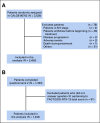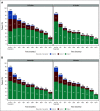Potential Mediators of Oxaliplatin-Induced Peripheral Neuropathy From Adjuvant Therapy in Stage III Colon Cancer: Findings From CALGB (Alliance)/SWOG 80702
- PMID: 36367997
- PMCID: PMC9928634
- DOI: 10.1200/JCO.22.01637
Potential Mediators of Oxaliplatin-Induced Peripheral Neuropathy From Adjuvant Therapy in Stage III Colon Cancer: Findings From CALGB (Alliance)/SWOG 80702
Abstract
Purpose: We sought to evaluate the independent and interactive associations of planned treatment duration, celecoxib use, physical activity, body mass index (BMI), diabetes mellitus, and vitamin B6 with oxaliplatin-induced peripheral neuropathy (OIPN) among patients with stage III colon cancer enrolled in a clinical trial.
Methods: We conducted a prospective, observational study of 2,450 patients with stage III colon cancer enrolled in the CALGB/SWOG 80702 trial, randomly assigned to 6 versus 12 cycles of adjuvant fluorouracil, leucovorin, and oxaliplatin chemotherapy with or without 3 years of celecoxib. OIPN was reported using the Common Terminology Criteria for Adverse Events (CTCAE) during and following completion of chemotherapy and the FACT/GOG-NTX-13 15-17 months after random assignment. Multivariate analyses were adjusted for baseline sociodemographic and clinical factors.
Results: Patients assigned to 12 treatment cycles, relative to 6, were significantly more likely to experience higher-grade CTCAE- and FACT/GOG-NTX-13-reported neuropathy and longer times to resolution, while neither celecoxib nor vitamin B6 intake attenuated OIPN. Exercising ≥ 9 MET-hours per week after treatment relative to < 9 was associated with improvements in FACT/GOG-NTX-13-reported OIPN (adjusted difference in means, 1.47; 95% CI, 0.49 to 2.45; P = .003). Compared with patients with baseline BMIs < 25, those with BMIs ≥ 25 were at significantly greater risk of developing higher-grade CTCAE-reported OIPN during (adjusted odds ratio, 1.18; 95% CI, 1.00 to 1.40; P = .05) and following completion (adjusted odds ratio, 1.23; 95% CI, 1.01 to 1.50; P = .04) of oxaliplatin treatment. Patients with diabetes were significantly more likely to experience worse FACT/GOG-NTX-13-reported neuropathy relative to those without (adjusted difference in means, -2.0; 95% CI, -3.3 to -0.73; P = .002). There were no significant interactions between oxaliplatin treatment duration and any of these potentially modifiable exposures.
Conclusion: Lower physical activity, higher BMI, diabetes, and longer planned treatment duration, but not celecoxib use or vitamin B6 intake, may be associated with significantly increased OIPN severity.
Trial registration: ClinicalTrials.gov NCT01150045.
Conflict of interest statement
Potential Mediators of Oxaliplatin-Induced Peripheral Neuropathy from Adjuvant Therapy in Stage III Colon Cancer: Findings from CALGB (Alliance)/SWOG 80702
The following represents disclosure information provided by authors of this manuscript. All relationships are considered compensated unless otherwise noted. Relationships are self-held unless noted. I = Immediate Family Member, Inst = My Institution. Relationships may not relate to the subject matter of this manuscript. For more information about ASCO's conflict of interest policy, please refer to
Open Payments is a public database containing information reported by companies about payments made to US-licensed physicians (
Figures



Similar articles
-
Time-dependent discrepancies between physician-assessed and patient-reported oxaliplatin-induced peripheral neuropathy in patients with metastatic colorectal cancer who received mFOLFOX6 plus bevacizumab: a post hoc analysis (WJOG4407GSS2).Support Care Cancer. 2021 Jul;29(7):3715-3723. doi: 10.1007/s00520-020-05891-2. Epub 2020 Nov 16. Support Care Cancer. 2021. PMID: 33200233
-
Impact of Lean Body Mass-Based Oxaliplatin Dose Calculation on Neurotoxicity in Adjuvant Treatment of Stage III Colon Cancer: Results of the Phase II Randomized LEANOX Trial.J Clin Oncol. 2025 Aug 10;43(23):2616-2627. doi: 10.1200/JCO-24-02754. Epub 2025 Jun 20. J Clin Oncol. 2025. PMID: 40540704 Free PMC article. Clinical Trial.
-
A placebo-controlled, double-blind, randomized study of recombinant thrombomodulin (ART-123) to prevent oxaliplatin-induced peripheral neuropathy.Cancer Chemother Pharmacol. 2020 Nov;86(5):607-618. doi: 10.1007/s00280-020-04135-8. Epub 2020 Sep 23. Cancer Chemother Pharmacol. 2020. PMID: 32965539 Free PMC article. Clinical Trial.
-
Phase III randomized, placebo-controlled, double-blind study of monosialotetrahexosylganglioside for the prevention of oxaliplatin-induced peripheral neurotoxicity in stage II/III colorectal cancer.Cancer Med. 2020 Jan;9(1):151-159. doi: 10.1002/cam4.2693. Epub 2019 Nov 13. Cancer Med. 2020. PMID: 31724334 Free PMC article. Clinical Trial.
-
Efficacy and Long-term Peripheral Sensory Neuropathy of 3 vs 6 Months of Oxaliplatin-Based Adjuvant Chemotherapy for Colon Cancer: The ACHIEVE Phase 3 Randomized Clinical Trial.JAMA Oncol. 2019 Nov 1;5(11):1574-1581. doi: 10.1001/jamaoncol.2019.2572. JAMA Oncol. 2019. PMID: 31513248 Free PMC article. Clinical Trial.
Cited by
-
Essential updates 2022-2023: Surgical and adjuvant therapies for locally advanced colorectal cancer.Ann Gastroenterol Surg. 2024 Aug 19;8(6):977-986. doi: 10.1002/ags3.12853. eCollection 2024 Nov. Ann Gastroenterol Surg. 2024. PMID: 39502729 Free PMC article. Review.
-
Oxaliplatin-induced peripheral neuropathy with hepatic arterial versus intravenous infusion in metastatic colorectal cancer.Support Care Cancer. 2024 Sep 16;32(10):660. doi: 10.1007/s00520-024-08807-6. Support Care Cancer. 2024. PMID: 39283505
-
Does statin suppress oxaliplatin-induced peripheral neuropathy in patients with colorectal cancer? A single-center observational study.Support Care Cancer. 2023 Oct 28;31(12):660. doi: 10.1007/s00520-023-08134-2. Support Care Cancer. 2023. PMID: 37897532 Free PMC article.
-
Peripheral Neuropathy Incidence in Children, and Adolescents and Young Adults With Cancer and Medicaid Insurance in California.JCO Oncol Pract. 2025 Apr 22:OP2400748. doi: 10.1200/OP-24-00748. Online ahead of print. JCO Oncol Pract. 2025. PMID: 40262078
-
Dietary quality and chemotherapy-induced peripheral neuropathy in colon cancer.Cancer. 2025 Jan 1;131(1):e35599. doi: 10.1002/cncr.35599. Epub 2024 Oct 5. Cancer. 2025. PMID: 39369275 Clinical Trial.
References
-
- Pulvers JN, Marx G. Factors associated with the development and severity of oxaliplatin-induced peripheral neuropathy: A systematic review. Asia Pac J Clin Oncol. 2017;13:345–355. - PubMed
-
- Hsu SY, Huang WS, Lee SH, et al. Incidence, severity, longitudinal trends and predictors of acute and chronic oxaliplatin-induced peripheral neuropathy in Taiwanese patients with colorectal cancer. Eur J Cancer Care (Engl) 2019;28:e12976. - PubMed
-
- Yamaguchi K, Kusaba H, Makiyama A, et al. The risk factors for oxaliplatin-induced peripheral sensory neuropathy and thrombocytopenia in advanced gastric cancer. Cancer Chemother Pharmacol. 2018;82:625–633. - PubMed
Publication types
MeSH terms
Substances
Associated data
Grants and funding
- U10 CA180868/CA/NCI NIH HHS/United States
- UG1 CA233290/CA/NCI NIH HHS/United States
- UG1 CA233320/CA/NCI NIH HHS/United States
- UG1 CA233234/CA/NCI NIH HHS/United States
- UG1 CA189974/CA/NCI NIH HHS/United States
- UG1 CA189858/CA/NCI NIH HHS/United States
- P30 CA008748/CA/NCI NIH HHS/United States
- UG1 CA189954/CA/NCI NIH HHS/United States
- U10 CA180882/CA/NCI NIH HHS/United States
- U10 CA180820/CA/NCI NIH HHS/United States
- UG1 CA233163/CA/NCI NIH HHS/United States
- U10 CA180888/CA/NCI NIH HHS/United States
- UG1 CA233339/CA/NCI NIH HHS/United States
- U10 CA180821/CA/NCI NIH HHS/United States
- UG1 CA233337/CA/NCI NIH HHS/United States
- U10 CA180863/CA/NCI NIH HHS/United States
- P30 CA015083/CA/NCI NIH HHS/United States
- UG1 CA233180/CA/NCI NIH HHS/United States
LinkOut - more resources
Full Text Sources
Medical
Miscellaneous

